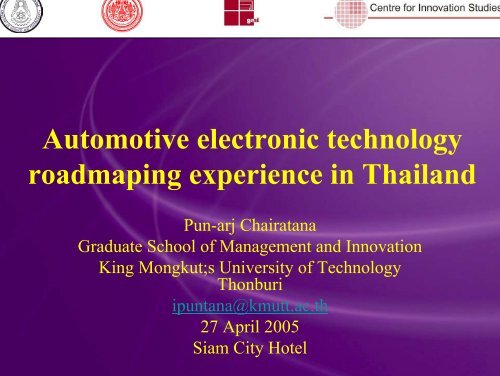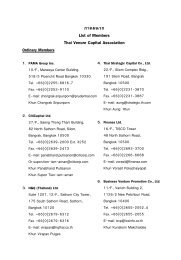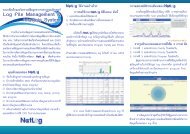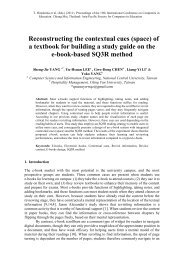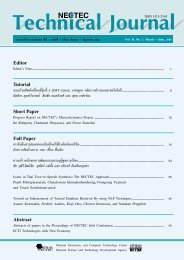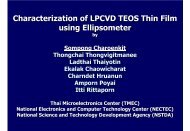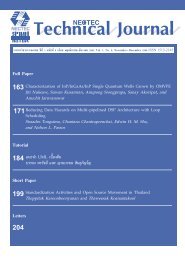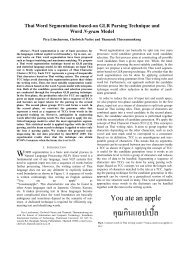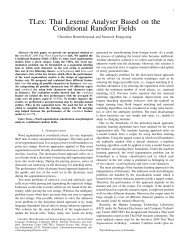Automotive electronic technology roadmaping experience ... - Nectec
Automotive electronic technology roadmaping experience ... - Nectec
Automotive electronic technology roadmaping experience ... - Nectec
You also want an ePaper? Increase the reach of your titles
YUMPU automatically turns print PDFs into web optimized ePapers that Google loves.
<strong>Automotive</strong> <strong>electronic</strong> <strong>technology</strong><strong>roadmaping</strong> <strong>experience</strong> in ThailandPun-arj ChairatanaGraduate School of Management and InnovationKing Mongkut;s University of TechnologyThonburiipuntana@kmutt.ac.th27 April 2005Siam City Hotel
TRM Benefits• Effective communication of developed<strong>technology</strong> strategy, and support for<strong>technology</strong> planning• Examples of companies that use roadmaps:Motorola, Philips, Lucent Technologies,ABB, etc.
TRM as an integrating mechanismStrategyMarket analysisFinanceTimeMarketM 1 M 2BenchmarkingProductT 1TechnologyP 1 P 2 P 3P 4T 3T 2 T 4ForesightR&DprogrammeResourcesRD 1 RD 2 RD 4 RD 6RD 2 RD 6Capital investment / financeSupply chainStaff / skillsTechnology auditProcessManufacturingAlliancesRisk assessmentSkillsStrategy formulationNew product introductionForecastingEngineeringR&D management
T-Plan: Fast-Start Technology RoadmappingAims• To support the start-up of company-specific TRM processes• To establish key linkages between <strong>technology</strong> resources and businessdrivers• To identify important gaps in market, product and <strong>technology</strong> intelligence• To develop a ‘first-cut’ <strong>technology</strong> route map• To support <strong>technology</strong> strategy and planning initiatives in the firm• To support communication between technical and commercial functions
Challenges• How to start up roadmapping in theorganisation?• How to keep roadmaps up-to-date?•• How to integrate roadmapping with otherstrategy and planning initiatives?
<strong>Automotive</strong> ElectronicsTechnology RoadmappingExperienceThe Case of the British Foresight VehicleTechnology Roadmap
The British Vehicle <strong>technology</strong>roadmap• Department of Trade and Industry (DTI)• 130 experts• 60 organisations• 6 broad themes have been used to structure theinformation contained in the roadmap– Social trends– Economic trends– Environmental trends– Technological trends– Political trends– Infrastructural trends
Foresight Vehicle TechnologyRoadmapping Process
Electronics and control technologicaltrends and drivers• Key performing areas: processing speed,miniaturisation, cost and functionality• Valueof <strong>electronic</strong>s and software in new vehicleswill continue to increase in the following areas:– Control and intelligence– Telematics– Information and service provision– Entertainment and user interfaces• The development and agreement of standards is a keyenabler
<strong>Automotive</strong> Electronics RoadmapProduct features and technologies• Performance measures and targets– Sensors, software and telematics: aim to improve vehicleperformance in terms of control, safety, adaptability,functionality, reliability, intelligence, driver support andintegration• Key <strong>technology</strong>– Advance software, sensors, <strong>electronic</strong>s and telematics(ASSET)• Shift to software• Access and use of vehicles• Architectures and reliability
Technology Evolution of<strong>Automotive</strong> Electronics20022007 2012 20172020VISION
3 Key Technology Areas• Shift to software– The general trends will be on vehicle design,manufacturing and use.– Major technical areas: vehicle control, adaptability and intelligence,with system integration being of particular importance• Access and use of vehicles– Software, sensors, <strong>electronic</strong>s and telematics <strong>technology</strong> will lead tosignificant mobility benefits,– In terms of improved safety reductions in congestion and crime,increasing access to mobility and greater vehicle adaptability• Architecture and reliability– Requirement of development of appropriate systems architectures andstandards, with an emphasis on safety and reliability– Long term vision leads to robust, tolerant and self-diagnosing andrepairing system that is also responsive to user requirements.
Thailand <strong>Automotive</strong> ElectronicsTechnology Roadmap Exercise 2005
T-Plan: Fast-Start Technology RoadmappingProcedureWorkshop 1MarketWorkshop 2ProductWorkshop 3TechnologyWorkshop 4Charting• Performancedimensions• Market / businessdrivers• Prioritisation• Product featureconcepts• Grouping• Impact ranking• Product strategy• Technologysolutions• Grouping• Impact ranking•Linking<strong>technology</strong>resources tofuture marketopportunities[Date] [Date] [Date] [Date]
<strong>Automotive</strong> <strong>electronic</strong>s defined• Defining automotive <strong>electronic</strong>s in Thailand– อิเลคทรอนิกสยานยนต คือ อิเลคทรอนิกสไฟฟา รวมถึงซอฟแวรหรือฮารดแวร และการสื่อสาร• Electronics system• Software development• Hardware design• Telematics• Intelligent Transportation System (ITS): Infotainmentสาระบันเทิง, Advanced Safety Vehicle (ASV)
Market segmentation• 1 ton pick-up• Small passenger car (Less <strong>electronic</strong>equipment options)• After market (REM)• Medium/large passenger cars• Bus & Truck
Market drivers I• ความสะดวกสบาย (Comforts)– ระบบอัตโนมัติ (Automatic system) เชนกระจกไฟฟา, Voicerecognition system– แผนที่นําทาง (Navigation) และระบบ Sensor รอบคัน– สภาพแวดลอมภายในหองโดยสาร เชน ระดับเสียงภายในหองโดยสาร (Acoustic) ระดับแสงสวางและอุณหภูมิภายในหองโดยสาร การลดการสั่น และกลิ่น– ระบบไรสาย (Wireless system) เชน ระบบควบคุม
Market driver II• การประหยัดพลังงาน (Fuel economy)– การเผาไหมของเครื่องยนต– การใช Electronic control, EGM, ECU– การใชเครื่องยนต Hybrid การมีรถไฟฟา หรือ Alternative fuelengine– Control by wire– แบตเตอรรี่ 42 Volts
Market driver III• สาระบันเทิง (Infotainment)– I/O device:– High Bandwidth– Voice interface–GPRS– Acoustic design– Wind screen– Driver and passenger modes
Market driver IV• ความปลอดภัย (Safety)– Security and safety alarm: กันขโมย– Sensors: Image, distance, speed– Processor and software
Market driver V• การอนุรักษสิ่งแวดลอมและการลดมลพิษ– Rule and regulation– Engine management system: ECM, ECU, EGR, Denox,SCR/CAT etc.– Noise and air pollution: ELV (End of life vehicle)
Identify competitors• Free trade (Global competition)– One market condition: ASEAN• Thailand gains competitive position among ASEAN competitors• China and India represent certain level of treat• Key competitors:– AFTA countries: Malaysia– New & Emerging competitors: China (potentialcompetitor) & India– Taiwan: car radio (focus on after market in the USA)
Competitors Strengths & Weaknesses• Strengths– Technology development– R&D (roles of R&D utilisation)– Economy of scale: market access, price– Supporting infrastructure: testing centre, quality assurance– Creditability: (leading competitors) Trust, branding etc.– Logistics• Weaknesses– Low quality (emerging competitors)– Reliability– Political atmosphere (some countries)– Investment promotion
Strategic implication• R&D• Knowledge creation (Know how)• Government support• Corporate investment policy• Domestic market• Absorptive capability• Knowledge transfer
Strengths• Social– Livable atmosphere– Life style (demand of automobile)• Technology– Sufficient knowledge workers in the fields of <strong>electronic</strong>s and computer science– Good manufacturing <strong>technology</strong>• Environment• Economic– Lots of multi-national OEM’s– Strong automotive production base of the world– Good environment to do business• Political– Strong political will: Detroit of Asia policy, Knowledge-based societypromotion– Political stability
Weaknesses• Social– Lack of trust in Thai <strong>technology</strong> products– Lack of systematic thinking and problem solving skills– Communication & language barriers– Education system: Mismatch between demand and supply• Technology– Lack of industrial infrastructure: testing labs, certify bodies– Lack of R&D activities in automotive <strong>electronic</strong>s– Lack of ICT infrastructure• Environment– Lack of law enforcement– Lack of green incentive• Economic– Insufficient IPR system– insufficient industrial linkage between automotive and <strong>electronic</strong> sectors• Political– Lack of specific government’s support on automotive <strong>electronic</strong>– Good governance problem
Opportunities• Social– Increasing demand in smarter car among new generation– Growth of automobile sector• Technology– Technology convergence: exploitation of new and existing technologies inemerging sector– Exploitation of RTO’s and Universities within the manufacturing proximities• Environment– Emission, safety standard, and fuel economy• Economic– Attractiveness for investors– As global pick-up manufacturing base (Good manufacturing infrastructure)– FTA (USA and Australia markets, etc.) and AFTA• Political– Expansion of car export value policy
Threats• Social– Increasing number of commuter using public transportation• Technology– No representatives in international standard control bodies– Technology follower• Environment– Non tariff barrier: EU, USA or Japan• Economic– Economic uncertainty: fuel prices, terrorism, tax system– FTA: China & India• Political– Policy conflicts
Next steps• Identify key product features• Identify key technologies• Develop <strong>Automotive</strong> <strong>electronic</strong> <strong>technology</strong>roadmap


